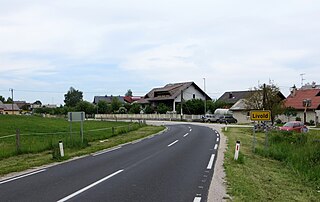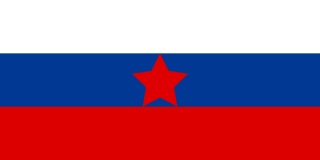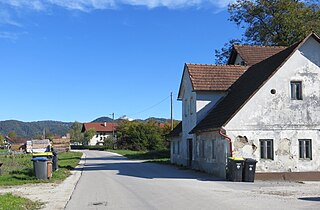
Franc Rozman, nom de guerre Stane or Stane Mlinar, was a Slovene Partisan commander in World War II.

TIGR, an abbreviation for Trst, Istra, Gorica, and Reka, full name Revolutionary Organization of the Julian March T.I.G.R., was a militant anti-fascist and insurgent organization established as a response to the Fascist Italianization of the Slovene and Croat people on part of the former Austro-Hungarian territories that became part of Italy after the First World War, and were known at the time as the Julian March. It is considered one of the first anti-fascist resistance movements in Europe. It was active between 1927 and 1941.

The Bleiburg repatriations occurred in May 1945, after the end of World War II in Europe, during which Yugoslavia had been occupied by the Axis powers, when tens of thousands of soldiers and civilians associated with the Axis powers fled Yugoslavia to Austria as the Yugoslav Partisans took control. When they reached Allied-occupied Austria, the British refused to accept their surrender and directed them to the Partisans instead. The prisoners of war were subjected to forced marches, together with columns captured by other Partisans in Yugoslavia. Tens of thousands were executed; others were taken to forced labor camps, where more died from harsh conditions. The events are named for the Carinthian border town of Bleiburg, where the initial repatriation was carried out.

The Yugoslav Partisans, or the National Liberation Army, officially the National Liberation Army and Partisan Detachments of Yugoslavia, was the communist-led anti-fascist resistance to the Axis powers in occupied Yugoslavia during World War II. Led by Josip Broz Tito, the Partisans are considered to be Europe's most effective anti-Axis resistance movement during World War II.

Boris Kidrič was a Slovene politician and revolutionary who was one of the chief organizers of the Slovene Partisans, the Slovene resistance against occupation by Nazi Germany and Fascist Italy after Operation Barbarossa in June 1941. He became the de facto leader of the Liberation Front of the Slovenian People. As such, he had a crucial role in the anti-Fascist liberation struggle in Slovenia between 1941 and 1945. After World War II he was, together with Edvard Kardelj, a leading Slovenian politician in communist Yugoslavia.

Begunje na Gorenjskem is a village in the Municipality of Radovljica in the Upper Carniola region of Slovenia. It is known for being the location of the headquarters of the Elan Line company.

The Battle of Dražgoše was a Second World War battle between the Slovene Partisans and Nazi Germany armed forces, which took place between January 9 and January 11, 1942, in the village of Dražgoše in German-annexed Slovenia. This battle was the first direct confrontation between the two. It ended with brutal reprisals of German forces against the villagers and the destruction of the village.

The Slovene Home Guard was a Slovene anti-Partisan military organization that was active during the 1943–1945 German occupation of the formerly Italian-occupied Province of Ljubljana. It consisted of former Village Sentries, part of Italian-sponsored Anti-Communist Volunteer Militia, re-organized under Nazi command after the Italian Armistice.

Gregorij Rožman was a Slovenian Roman Catholic prelate. Between 1930 and 1959, he served as bishop of the Diocese of Ljubljana. He may be best-remembered for his controversial role during World War II. Rožman was an ardent anti-communist and opposed the Liberation Front of the Slovene People and the Partisan forces because they were led by the Communist party. He established relations with both the fascist and Nazi occupying powers, issued proclamations of support for the occupying authorities, and supported armed collaborationist forces organized by the fascist and Nazi occupiers. The Yugoslav Communist government convicted him in absentia in August 1946 of treason for collaborating with the Nazis against the Yugoslav resistance. In 2009, his conviction was annulled on procedural grounds.
Dušan Pirjevec, known by his nom de guerre Ahac, was a Slovenian Partisan, literary historian and philosopher. He was one of the most influential public intellectuals in post–World War II Slovenia.
Primorski dnevnik, mostly known as Primorski, is a Slovene language daily newspaper published in Trieste, Italy. It is the only Slovene daily in any country other than Slovenia, and one of the three historical daily newspapers in Italy published in a language other than Italian. It is primarily published for the Slovene minority in Italy.

The Museum of 4 July was a museum located in Belgrade, the capital of Serbia. It was established in 1950 in the house where members of the Central Committee of the Communist Party of Yugoslavia decided to encourage the people's uprising against Yugoslavia's German occupiers on 4 July 1941. That date was later dubbed Fighter's Day, a public holiday during the existence of Socialist Federal Republic of Yugoslavia.

Livold is a village in the Kočevje Polje southeast of the town of Kočevje in southern Slovenia. The area is part of the traditional region of Lower Carniola and is now included in the Southeast Slovenia Statistical Region. The village stretches along the road connecting Kočevje and Petrina, near the turn to Mozelj. It has a pronounced outline. The Rinža River flows through the village; it often goes dry in the summer but floods during heavy rains. There are many karst caves in the area. The Stojna Ridge and Dry Hill rise to the west, and the karstified Šahen lowland lies to the east.
The Tomb of National Heroes in Ljubljana, Slovenia is a tomb and a monument for the national heroes of the World War II resistance struggle in Slovenia, created in 1949. The designers of the tomb and the monument were the architect Edo Mihevc and the sculptor Boris Kalin. It stands next to Šubic Street, at the southern side of National Heroes Square, west of the National Assembly Building. It has been protected as a cultural monument of local significance.

The Slovene Partisans, formally the National Liberation Army and Partisan Detachments of Slovenia, were part of Europe's most effective anti-Nazi resistance movement led by Yugoslav revolutionary communists during World War II, the Yugoslav Partisans. Since a quarter of Slovene ethnic territory and approximately 327,000 out of total population of 1.3 million Slovenes were subjected to forced Italianization since the end of the First World War, the objective of the movement was the establishment of the state of Slovenes that would include the majority of Slovenes within a socialist Yugoslav federation in the postwar period.
Hrib pri Koprivniku is a remote almost abandoned settlement in the Municipality of Kočevje in southern Slovenia. The area is part of the traditional region of Lower Carniola and is now included in the Southeast Slovenia Statistical Region.
Pugled pri Starem Logu is an abandoned settlement in the hills north of the town of Kočevje in southern Slovenia. The area is part of the traditional region of Lower Carniola and is now included in the Southeast Slovenia Statistical Region.
World War II in the Slovene Lands started in April 1941 and lasted until May 1945. Slovene Lands was in a unique situation during World War II in Europe, only Greece shared its experience of being trisected, however, Drava Banovina was the only region that experienced a further step — absorption and annexation into neighboring Nazi Germany, Fascist Italy, and Hungary. The Slovene-settled territory was divided largely between Nazi Germany and the Kingdom of Italy, with smaller territories occupied and annexed by Hungary and the Independent State of Croatia.

The Tezno massacre was the mass killing of POWs and civilians of the Independent State of Croatia (NDH) that took place in Tezno near Maribor, after the end of World War II in Yugoslavia. The killings were perpetrated by units of the Yugoslav Partisans in May 1945, in the Bleiburg repatriations. Summary executions began on 19 May when first prisoners arrived to the Tezno forest from nearby prison camps and continued until 26 May. Most of the bodies were buried in a several kilometers long antitank trench, which the Yugoslav authorities concealed and kept secret.

Dobrunje is a formerly independent settlement in the southeast part of the capital Ljubljana in central Slovenia. It belongs to the City Municipality of Ljubljana. It is part of the traditional region of Lower Carniola and is now included with the rest of the municipality in the Central Slovenia Statistical Region. In addition to the main settlement, Dobrunje consists of the hamlets of Devce, Marinki, Na Trdnjavi, Ob Cesti, and Pod Ježo. Rastučnik Creek, which begins below Orle, runs through the western part of the settlement before joining the Ljubljanica.























